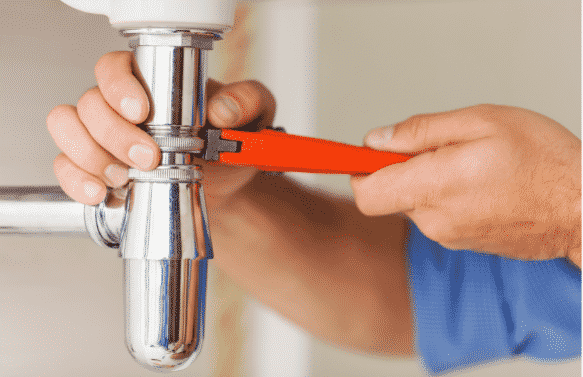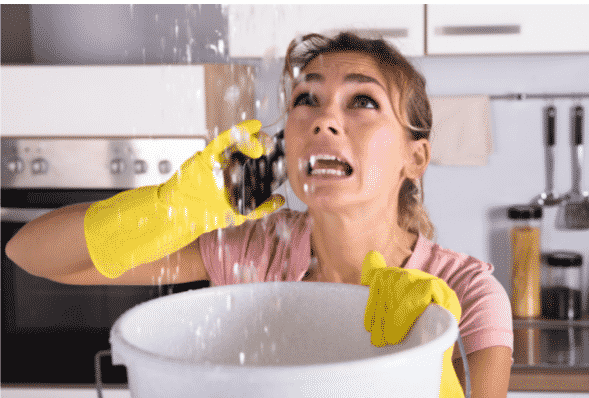A typical household in the United States loses up to 20,000 gallons of water annually from plumbing leaks. Therefore, if you want to sell or buy a house, you need to pay close attention to your plumbing system.
Regardless of the age of your home, a plumbing leak can result in the damage to your home, to home fixtures, or even home furnishings, not to mention the waste of water and of course the financial repercussions of having to fix everything that water touches. The easiest way to detect a plumbing leak is through your water meter. All you need to do is turn off all the water running in your house, and if your meter still records water use, you probably have a plumbing leak. Some plumbing leaks are more common than others and will occur more frequently. Others will take years before recurring; therefore, preventing or stopping them before they cause major damage is vital. You can repair some of these plumbing leaks yourself, but others are too technical, requiring professional help.
Fortunately, you can prevent these leaks and keep your house in good condition with regular inspection and maintenance. A professional home inspector will help you understand more about these issues and the need for regular inspections. Read on as we take you through the 5 common plumbing leaks you should look out for:
- Toilet Leaks
- Water Heater Leaks
- Dripping Faucets
- Sink Leaks
- Shower and Tub Leaks
Let’s take a look at each of these plumbing leaks, why they’re important to inspect, and how they can affect your home.
Toilet Leaks
Your toilet water may be running into the toilet bowl throughout, resulting in water wastage. This is the most common type of plumbing leak and is common in almost all households globally. A toilet leak could result from a faulty flapper or flipping mechanism. The toilet flapper prevents water from entering the bowl until you flush the toilet. Over time, it can become loose and allow water to trickle into the bowl. Toilet leaks could also result from an imbalanced float or a loose fill tube requiring replacement or tightening.
To check if your toilet is leaking, open the tank lid and check the water level. Generally, the water level should be below the top of the overflow tube at a one-inch difference. You can also dye test your toilet using food coloring. To do this, add one or more drops of food coloring to every toilet tank in your house. If your toilet is leaking, you will find this color in the bowl within five to twenty minutes. You should then call the plumber to identify the cause and repair or fix it by yourself.
Water Heater
Checking for signs of leakage in your water heater is important, especially if you are using a traditional water heater. This is because such systems have plenty of water throughout and undergo regular temperature shifts, which may cause the seal to decay. Water heater plumbing leaks could also result from mineral deposits which affect the supply of hot water by affecting the water heater’s efficacy.
Generally, a water heater leak will occur if the pressure relief valve gets damaged. The most common signs of a water heater leakage include dripping water, discolored water, and hissing or any other noise from the water heater unit caused by sediment heating and explosion. You can troubleshoot some of these problems, but in most cases, you will likely require professional intervention given the complexity and dangers associated with a water heater.
Dripping Faucets
Do you consider a dripping faucet as a leak? Well, to your surprise, dripping faucets are a common plumbing leak in most American homes and apartments. A dripping faucet generally means water getting out when it should not be, resulting in wastage. Drippy faucets occur when the washer that seals the tap gets damaged through stiffening, tearing, or dislodging. High water pressure and deterioration may also cause a dripping faucet. A damaged washer is sealed loosely, allowing water to drip from the faucet. Failure to repair the washer may also cause the valve seat to corrode or wear. A faucet leaking one drop every second will cause up to 3,000 gallons of water loss annually, equating to an average of 180 baths, not to mention the monetary loss associated with the water loss.
Despite being a common plumbing leak, dripping faucets are easy to spot and repair. This is because the water will visibly drip out of the faucet, and you can hear the drips falling even if you are not in the room. To fix a dripping faucet, replace the washer yourself if you are good with DIY (do it yourself) projects. However, it is advisable to call a plumber to do this fix for you with their special tools. This is because a seemingly simple fix could cause a big mess if handled by a nonprofessional. After repair, you can prevent reoccurrence by slowly turning your facets to prevent excessive pressure that quickly wears them out. Failure to fix a dripping faucet on time may cause major damages affecting the sale of your home.
Sink Leaks
Sink leaks are complex and could occur on the rim or the supply point. When they occur, they are gradual and will destroy your kitchen and bathroom countertops and cabinets. Usually, you will notice these damages when they are already severe. Some of the signs of a leaking sink include water stains or dampness inside the cabinet, a loose plastic laminate around the sink area, or a loose faucet base and a deteriorating caulk. If you spot one or more of the above signs of leakage, start by examining your countertops with a flashlight, checking for swollen particle boards or any other signs of leakage.
Another common sink leak is the supply leak. This plumbing leak can go unnoticed for months because it is at the back of the cabinet. For this reason, your house inspector must ensure a thorough check-up and save on the costs of repairing such hidden leaks. If undetected, the water will continue running into your floor and rot the sink base. If your sink is upstairs, these leaks will damage your ceiling through discoloration.
To detect a sink supply leak, check for stains on the ceiling below your sink area. You should also check for dampness or water stains under the sink and inside the cabinet. You can do this by running your dishwasher and checking for any water leakage underneath. Alternatively, wrap the connections with dry tissue paper and look for wet spots.
To fix a sink leak, tighten the faucet base and clips that clamp the sink to your countertop. If you have a caulked rim, remove the old caulk through scraping and recaulk. Tightening the packing nut or replacing the valve will also fix most of your sink defects, but you may need to disassemble the whole unit in some instances. In the latter case, it is advisable to contact a plumber for professional assistance.
Showers and Tubs
Showers and tubs seem to be an obvious plumbing leak; however, despite being common, they are challenging to detect since they’re mostly surrounded by tiles. Also, given that the bathroom is wet most of the day, spotting a leak is fairly hard, and you may need to contact a professional home inspector for assistance.
A leaky shower head is evident when it incessantly drips, which can be quite irritating. In addition to the annoying sound of these drips, a leaking shower is expensive over time, especially if the leak emanates from the hot shower valve, as you’re paying for water and heat. In most cases, your shower head is perfectly functional, yet the problem lies in the valve, requiring replacement. However, before ruling out the cause, you should first confirm the presence of the leakage.
To do this, look out for more than the usual amount of water in your tub or sink, and, while at it, check the water pressure. Low water pressure is a sign that your system has a leakage. Fixing the faucet valve on your own can stop the leakage. However, this is only possible if you are good with DIY, but it is advisable to contact a plumber for assistance, especially if your faucet is an in-wall.
So, Do These Plumbing Leaks Matter?
Given the above plumbing leaks, it is worth noting that they are almost inevitable unless you conduct thorough and frequent plumbing maintenance. To ensure this, you will need a house inspector. A house inspector will identify the defects in your property to alert you of the need for maintenance before these defects worsen. This information is especially useful for a potential seller or buyer, as you (they) will assess the maintenance costs before paying for the property.
If you are a buyer and find the repairs to be too many, you may opt to quit or renegotiate with the seller to reduce the cost and enable you to fix the plumbing leaks. As a seller, you may either gain more confidence in selling the house depending on the leaks or be devastated by the many plumbing leaks that require repair before listing your home for sale.
Regardless of the outcome, you can reach us for assistance. With over 25 years of experience in the industry, we offer trusted inspection services, and our customer reviews confirm our reliability and quality service to ensure you are not disappointed.



